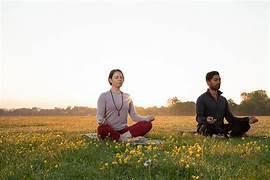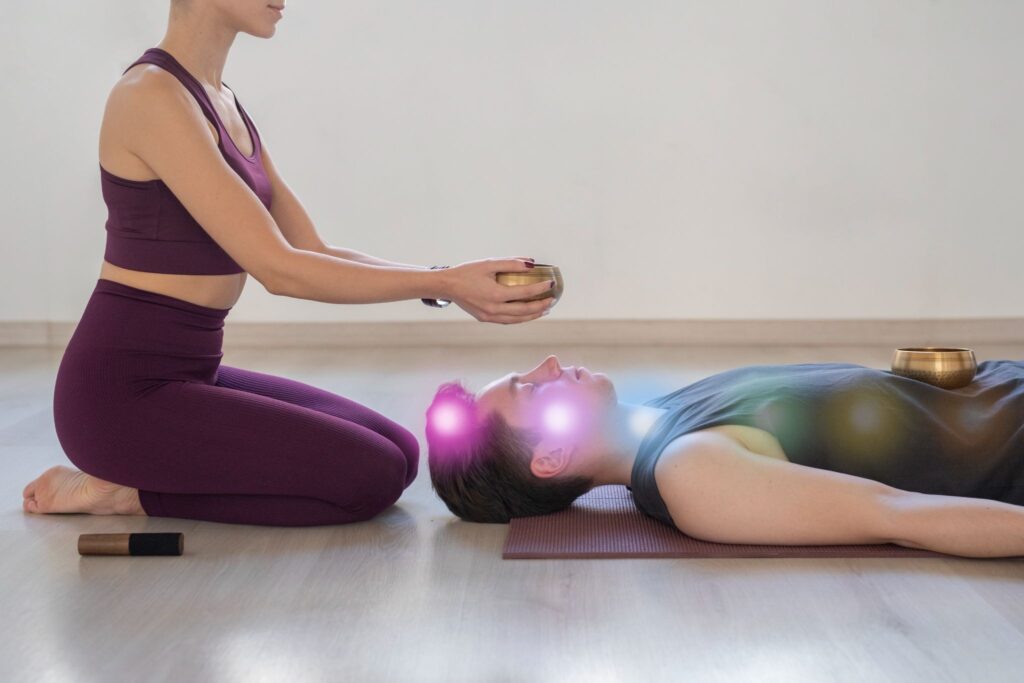Long appreciated for its physical advantages—increased flexibility, strength, and general fitness—yoga has, in recent years, become better known for its influence on the mind and emotions. Fundamentally, yoga provides a whole approach that takes into consideration not only the physical but also the psychological and emotional components of our existence, making it a powerful tool for emotional healing with yoga. This turns yoga into a very successful treatment for psycho-emotional injuries—those invisible scars left by trauma, tension, worry, sadness, and other mental health challenges.
In this section, we will explore how yoga facilitates the healing of psycho-emotional injuries through its ability to assist individuals in processing and releasing emotions that are repressed, alleviating stress, and helping individuals find a sense of inner peace. A better understanding of the possibility of healing through yoga allows us to better appreciate how the practice connects mind, body, and spirit to provide a holistic approach to emotional well-being.
The Mind-Body Connection: Emotional Healing with Yoga

The concept of the mind-body connection, which refers to the understanding that our physical health is deeply connected to our mental and emotional health, is one of the most valuable concepts in yoga. The healing of psycho-emotional wounds relies upon the mind-body connection in many ways. Yogic philosophy states that trauma and unexperienced feelings sometimes become lodged in the body and appear as physical tension, pain, or discomfort. These emotional obstacles can inhibit our ability to experience inner calm and negatively influence our mental health by contributing to depression, anxiety, and chronic stress.
Yoga aims to restore health in both the body and the mind by drawing attention to both. Yoga helps practitioners ease physical tension while building emotional awareness through intentional movement, breathwork, and meditation. This simultaneous approach to healing allows an individual to confront and process emotions that may have been repressed, which releases emotional energy and promotes healing.
The Role of Breathwork (Pranayama) in Emotional Healing
A key aspect of a yoga practice is breath, as it can assist in healing emotional and psychological wounds. Intentional breathing techniques referred to as pranayama can provide a calming effect on the nervous system, reduce stress, and bring the mind back to the present moment. During emotional distress or anxiety, our breathing becomes shallow and quick, which can often heighten anxiety or overwhelm. By intentionally controlling our breath, we can stimulate our parasympathetic nervous system to create a relaxed state of being and emotional balance.
Breathwork can be powerful for individuals who are struggling with psycho-emotional injury. It can create a way to access a deeper level of inner peace and the ability to release emotions that have been contained. Several yoga techniques that can help bring emotional balance are alternate nostril breathing (Nadi Shodhana), deep abdominal breathing (Dirga Pranayama), and Ujjayi breath.
The Science Behind Breath and Emotional Healing
Research has suggested that taking slow, deep breaths assists the autonomic nervous system by lowering the stress hormone and increasing the production of feel-good neurotransmitters such as dopamine and serotonin. Pranayama techniques have also been shown to decrease anxiety, reduce symptoms of depression, and help re-establish emotional regulation. At its core, intentional breathing helps someone regain control over their emotional responses and, in turn, creates more calm and steadiness in their life.
Mindfulness and Meditation: Cultivating Emotional Awareness

Yoga is a practice of mindfulness as well as physical movement. Mindfulness in yoga is defined as the nonjudgmental awareness of the present moment. Because people are more aware of this moment, they also have more awareness of their thoughts and feelings from a place of non-attachment, which is necessary to heal psych-emotional wounds.
Feeling and experiencing mindfulness on the mat is useful to support a greater awareness of their emotional state. This awareness can organize their feelings with emotional triggers, thinking patterns, and conflict that may be related to an unresolved or past trauma. Noticing those feelings with curiosity and without judgment creates a safe space to heal. Furthermore, as individuals practice mindfulness, they become better at reframing negative thinking patterns, developing emotional resiliency, and extending compassion to themselves.
Meditation as a Tool for Healing
An integral part of many yoga traditions, meditation enables a deeper connection to the subconscious mind and the present moment. Individuals must sit in stillness and observe their thoughts. This allows thoughts to arise and to be released without attachment. This self-observational practice can also expose deep-seated emotional wounds. Thus, it creates an opportunity for those wounds to be processed more consciously.
As well, meditation can be a powerful tool for those recovering from emotional distress or trauma. Techniques, including loving-kindness meditation, which promotes compassion and forgiveness, can be beneficial when working towards self-love and acceptance. Meditation promotes a non-judgmental awareness of the present moment. It can free negative emotions and allow emotional wounds time to heal on their own.
Yoga Postures (Asanas): Releasing Tension and Trauma
Yoga postures, or asanas, can be performed to open the body, stretch tight muscles, and relieve physical strain. However, asanas are also a very important way to release emotional pent-up energy trapped in the body. Many of us carry emotional pain in specific areas of the body, especially the shoulders, chest, and hips. By the gentle stretching and release of these muscles, yoga provides a deep release of emotionally charged energy.
Postures like Child’s Pose, Pigeon Pose, and Heart-Opening Postures are popular for the release of emotional tension. These poses are known to address some of the areas in the body that often carry emotional strain. These postures also increase physical flexibility but facilitate the opening of deeper emotional work to address and release.
Trauma-Informed Yoga
Individuals who have experienced significant past trauma may find that trauma-informed yoga practice is particularly beneficial. Trauma-informed yoga emphasizes awareness of the body, consent, and safety. Teachers learn to create an environment that empowers students and helps them feel in control of their own experience. This approach allows individuals to connect with their bodies safely and release trauma without overwhelming their senses.
Trauma-informed yoga asks that individuals move their bodies at the pace they choose, honoring their bodies’ limitations. This ensures that the students never feel pressured to go beyond their comfort zone. This practice enhances self-empowerment and control, two essential aspects of recovering from emotional pain from the past.
Yoga Philosophy: Cultivating Compassion and Acceptance
In addition to being a physical practice, yoga represents a spiritual and philosophical legacy. One of the fundamental aspects of yoga is embracing ahimsa, meaning nonviolence, as both relating to how we treat others and how we treat ourselves as well. This self-compassion attitude is critical to healing psycho-emotional trauma.
It is easy to be self-critical or harsh when experiencing emotional pain or trauma. One might feel “broken” or “not good enough.” In yoga, we learn to treat ourselves with compassion and non-judgment, instead of holding on to these untrue and destructive beliefs about ourselves.
Developing self-compassion allows the person healing from emotional trauma to let go of shame, guilt, and negative self-talk.
Letting go is another key element of yoga philosophy. In yoga we learn how to let go of attachments, whether it may be to negative emotions, bad thoughts or past events. One of the most significant steps in the healing of emotional scars is to allow a person to move forward without carrying the burden of an injury. It is allowing the person to let go.
The Healing Power of Community
Many individuals practice yoga in a group context; not only can the community and support surrounding a yoga session be healing for those going through emotional pain, but being in the same physical setting with other individuals on their own healing journeys can also create a sense of connection and belonging. The collective energy in a room during a yoga class can help create a safe and supportive space for individuals to feel more confident in opening up and releasing emotional tension.
In addition to group classes, many individuals also find healing through one-on-one sessions or yoga practices with a therapist, which adds a tailored approach to healing emotionally traumatic experiences.
Conclusion
Yoga is a practice that promotes a holistic and total method of healing emotional injuries. Yoga encompasses physical movement, breath work, meditation, mindfulness mental aspect of yoga, and philosophical teachings that help individuals to address the root causes of emotional suffering. Throughout, yoga practitioners are in a safe environment to address and experience suppressed emotions, and to relieve stress and cultivate inner peace.
Regular engagement in yoga provides practitioners an opportunity to reconnect with their bodies, acknowledge their feelings, and integrate frameworks to heal previous wounds. Yoga offers a perspective of life based on an open heart, self-compassion, and emotional flexibility. It offers a pathway to emotional liberation, where practitioners can begin to heal wounds of the past and step forward into a life filled with peace, self-love, and healing.
This can begin as an adventure for prospective practitioners and could be for the most experienced yogi; on a continuum of emotional distress, yoga offers accessible solutions for continuing balance, harmony, and health of the mind and body.





